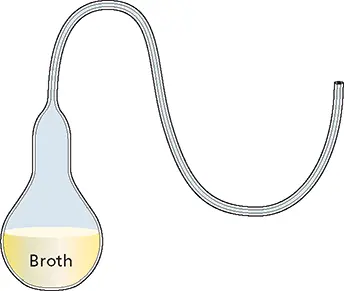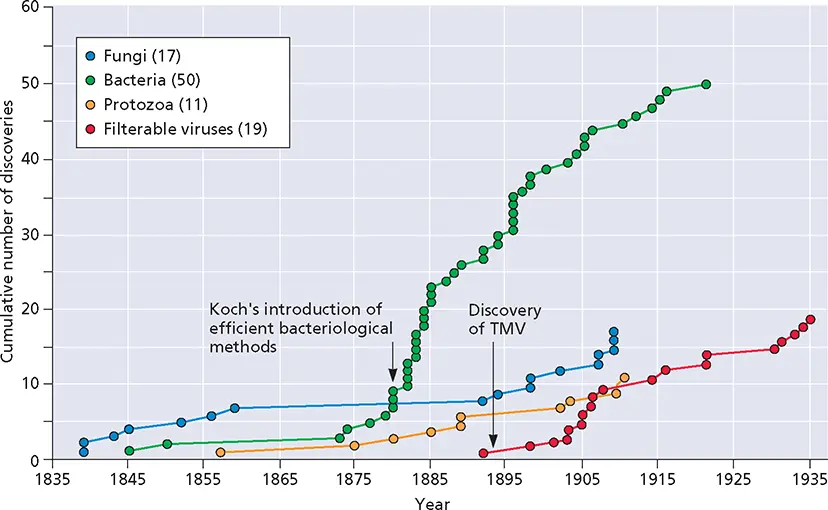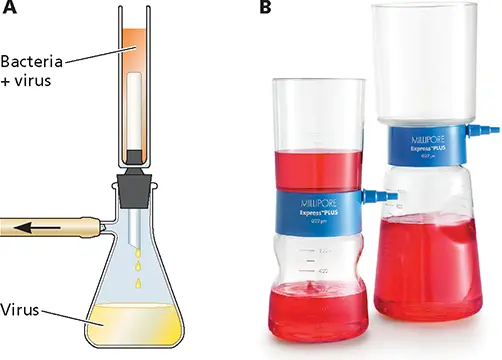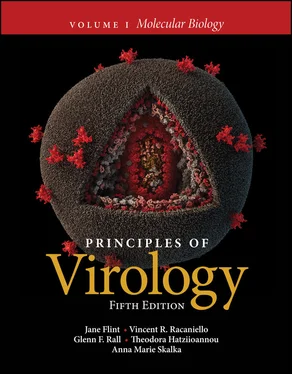Jane Flint - Principles of Virology, Volume 1
Здесь есть возможность читать онлайн «Jane Flint - Principles of Virology, Volume 1» — ознакомительный отрывок электронной книги совершенно бесплатно, а после прочтения отрывка купить полную версию. В некоторых случаях можно слушать аудио, скачать через торрент в формате fb2 и присутствует краткое содержание. Жанр: unrecognised, на английском языке. Описание произведения, (предисловие) а так же отзывы посетителей доступны на портале библиотеки ЛибКат.
- Название:Principles of Virology, Volume 1
- Автор:
- Жанр:
- Год:неизвестен
- ISBN:нет данных
- Рейтинг книги:5 / 5. Голосов: 1
-
Избранное:Добавить в избранное
- Отзывы:
-
Ваша оценка:
- 100
- 1
- 2
- 3
- 4
- 5
Principles of Virology, Volume 1: краткое содержание, описание и аннотация
Предлагаем к чтению аннотацию, описание, краткое содержание или предисловие (зависит от того, что написал сам автор книги «Principles of Virology, Volume 1»). Если вы не нашли необходимую информацию о книге — напишите в комментариях, мы постараемся отыскать её.
Volume I: Molecular Biology
Volume II: Pathogenesis and Control
Principles of Virology, Fifth Edition
Principles of Virology, Volume 1 — читать онлайн ознакомительный отрывок
Ниже представлен текст книги, разбитый по страницам. Система сохранения места последней прочитанной страницы, позволяет с удобством читать онлайн бесплатно книгу «Principles of Virology, Volume 1», без необходимости каждый раз заново искать на чём Вы остановились. Поставьте закладку, и сможете в любой момент перейти на страницу, на которой закончили чтение.
Интервал:
Закладка:
Schrick L, Tausch SH, Dabrowski PW, Damaso CR, Esparza J, Nitsche A. 2017. An early American smallpox vaccine based on horsepox. N Engl J Med 377:1491–1492.
TWIV 478: A pox on your horse. http://www.microbe.tv/twiv/twiv-478/.
The organism must be regularly associated with the disease and its characteristic lesions.
The organism must be isolated from the diseased host and grown in culture.
The disease must be reproduced when a pure culture of the organism is introduced into a healthy, susceptible host.
The same organism must be reisolated from the experimentally infected host.
Modern technology has allowed some of Koch’s principles to be amended by the application of other types of evidence ( Box 1.4). However, by applying his criteria, Koch demonstrated that anthrax, a common disease of cattle, was caused by a specific bacterium (designated Bacillus anthracis ) and that a second, distinct bacterial species caused tuberculosis in humans. Guided by these postulates and the methods for the sterile culture and isolation of pure preparations of bacteria developed by Pasteur, Joseph Lister, and Koch, many pathogenic bacteria (as well as yeasts and fungi) were identified and classified during the last part of the 19th century ( Fig. 1.7). From these beginnings, investigation into the causes of infectious disease was placed on a secure scientific foundation, the first step toward rational treatment and ultimately control. Furthermore, during the last decade of the 19th century, failures of the paradigm that bacterial or fungal agents are responsible for alldiseases led to the identification of a new class of infectious agents—submicroscopic pathogens that came to be called viruses.

Figure 1.6 Pasteur’s famous swan-neck flasks provided passive exclusion of microbes from the sterilized broth. Although the flask was freely open to the air at the end of the long, curved stem, the broth remained sterile, provided that microbe-bearing dust that collected in the neck of the stem did not reach the liquid.
Discovery of Viruses
The first report of a pathogenic agent smaller than any known bacterium appeared in 1892. The Russian scientist Dimitrii Ivanovsky observed that the causative agent of tobacco mosaic disease was not retained by the unglazed filters used at that time to remove bacteria from extracts and culture medium ( Fig. 1.8A). Six years later in Holland, Martinus Beijerinck independently made the same observation. More importantly, Beijerinck made the conceptual leap that this must be a distinctive agent, because it was so small that it could pass through filters that trapped all known bacteria. However, Beijerinck thought that the agent was an infectious liquid. It was two former students and assistants of Koch, Friedrich Loeffler and Paul Frosch, who in the same year (1898) deduced that such infectious filterable agents comprised small particles: they observed that while the causative agent of foot-and-mouth disease ( Box 1.2) passed through filters that held back bacteria, it could be retained by a finer filter.
Not only were the tobacco mosaic and foot-and-mouth disease pathogens much smaller than any previously recognized microorganism, but also they could only reproduce in their host organisms. For example, extracts of an infected tobacco plant diluted into sterile solution produced no additional infectious agents until introduced into leaves of healthy plants, which subsequently developed tobacco mosaic disease. The serial transmission of infection by diluted extracts established that these diseases were not caused by a bacterial toxin present in the original preparations derived from infected tobacco plants or cattle. The failure of both pathogens to multiply in solutions that readily supported the growth of bacteria, as well as their dependence on host organisms for reproduction, further distinguished these new agents from pathogenic bacteria. Beijerinck termed the submicroscopic agent responsible for tobacco mosaic disease contagium vivum fluidum to emphasize its infectious nature and distinctive reproductive and physical properties. Agents passing through filters that retain bacteria came to be called ultrafilterable viruses, appropriating the term virus from the Latin for “poison.” This term was simplified eventually to “virus.”
BOX 1.4
DISCUSSION
New methods amend Koch’s principles
While it is clear that a microbe that fulfills Koch’s postulates is almost certainly the cause of the disease in question, we now know that microbes that do not fulfill such criteria may still represent the etiological agents of disease. In the latter part of the 20th century, new methods were developed to associate particular viruses with disease based on immunological evidence of infection, for example, the presence of antibodies in blood. The availability of these methods led to the proposal of modified “molecular Koch’s postulates” based on the application of molecular techniques to monitor the role played by virulence genes in bacteria.
The most revolutionary advances in our ability to link particular viruses with disease (or benefit) come from the more recent development of high-throughput nucleic acid sequencing methods and bioinformatics tools that allow detection of viral genetic material directly in environmental or biological samples, an approach called viral metagenomics. Based on these developments, alternative “metagenomic Koch’s postulates” have been proposed in which (i) the definitive traits are molecular markers such as genes or full genomes that can uniquely distinguish samples obtained from diseased subjects from those obtained from matched, healthy control subjects and (ii) inoculating a healthy individual with a sample from a diseased subject results in transmission of the disease as well as the molecular markers.
Falkow S. 1988. Molecular Koch’s postulates applied to microbial pathogenicity. Rev Infect Dis 10(Suppl 2):S274–S276.
Fredricks DN, Relman DA. 1996. Sequence-based identification of microbial pathogens: a reconsideration of Koch’s postulates. Clin Microbiol Rev 9:18–33.
Mokili JL, Rohwer F, Dutilh BE. 2012. Metagenomics and future perspectives in virus discovery. Curr Opin Virol 2:63–77.
Racaniello V. 22 January 2010. Koch’s postulates in the 21st century. Virology Blog. http://www.virology.ws/2010/01/22/kochs-postulates-in-the-21st-century/.

Figure 1.7 The pace of discovery of new infectious agents in the dawn of virology. Koch’s introduction of efficient bacteriological techniques spawned an explosion of new discoveries of bacterial agents in the early 1880s. Similarly, the discovery of filterable agents launched the field of virology in the early 1900s. Despite an early surge of virus discovery, only 19 distinct human viruses had been reported by 1935. TMV, tobacco mosaic virus. Data from Burdon KL. 1939. Medical Microbiology (Macmillan Co, New York, NY).

Figure 1.8 Filter systems used to characterize/purify virus particles. (A)The Berkefeld filter, invented in Germany in 1891, was a “candle”-style filter comprising diatomaceous earth (called Kieselguhr), pressed into a hollow candle shape. The white candle in the upper chamber is open at the top to receive the liquid to be filtered. The smallest pore size retained bacteria and let virus particles pass through. Such filters were probably used by Ivanovsky, Loeffler, and Frosch to isolate the first viruses. (B)Modern-day filter systems are made of disposable plastic with the upper and lower chambers separated by a biologically inert membrane, available in a variety of pore sizes. Such filtration approaches may have limited our detection of giant viruses. Image courtesy of EMD Millipore Corporation.
Читать дальшеИнтервал:
Закладка:
Похожие книги на «Principles of Virology, Volume 1»
Представляем Вашему вниманию похожие книги на «Principles of Virology, Volume 1» списком для выбора. Мы отобрали схожую по названию и смыслу литературу в надежде предоставить читателям больше вариантов отыскать новые, интересные, ещё непрочитанные произведения.
Обсуждение, отзывы о книге «Principles of Virology, Volume 1» и просто собственные мнения читателей. Оставьте ваши комментарии, напишите, что Вы думаете о произведении, его смысле или главных героях. Укажите что конкретно понравилось, а что нет, и почему Вы так считаете.



